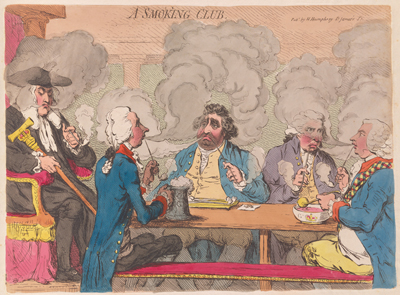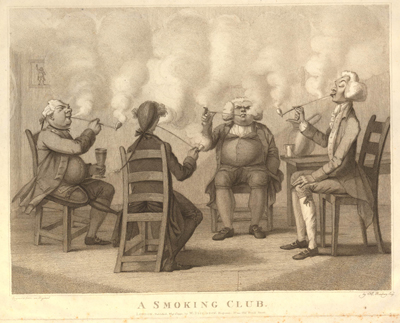A Smoking Club
In this print, Gillray uses caricature's power of visual equivalence to suggest that Parliament is no better than a smoking club where the ranking members blow (verbal) smoke at one another and are more interested in obfuscation than legislation. The plain tavern table is set up as in Parliament with the ministry members on one side and the opposition members on the other. The bench they sit on, however, resembles the benches in Parliament, and a "speaker" with a crutch resembing the ceremonial mace sits positioned to preside.

© Beinecke Rare Book & Manuscript Library, Yale University
In this appparent smoking contest, Prime Minister William Pitt seems to be getting the better of his sad-looking opposition counterpart, Charles James Fox. And Pitt's right hand man, Home Secretary Henry Dundas (in tartan) seems to have a similar edge over his Whig opponent, Richard Brinsley Sheridan. The ministry pair have the significant support of the royal tankard and bowl, both inscribed with the "GR" of George Rex (king), leaving Fox with only one option, to light up another pipe and try again.
If the February 1793 publication date of the print can be believed there was good reason for the Whigs to look and feel discomfited; the revolutionary government in France (much praised by the Whigs) had just concluded the mockery of a trial of their sovereign and on January 21, 1793 sent Louis XVI to the guillotine.
The fifth man in the print is a matter of some dispute. If we are meant to see this tavern as a miniature House of Commons, the speaker's chair ought to be be occupied by Henry Addington. But the man with the speaker's mace/crutch does not look like Addington as he is portrayed in other Gillray prints (with a prominent nose and receding chin). He does, however, resemble Alexander Wedderburn, Baron Loughborough, who had just become Lord Chancellor in the House of Lords on January 28, 1793, a few weeks before the nominal publication date of this print, and who later makes an appearance in Gillray's The Death of the Great Wolf (1795) as the Indian Chief. That resemblance and his seeming indifference to both sets of smokers may account for the fact that Wright and Evans identify the man as Loughborough who had been both Whig and Tory, but whose real allegiance seems to have been to himself. And in fact Gillray may have purposely decided to include Loughborough rather than Addington in order to expand and generalize his satire to include both houses of Parliament.
All of this becomes a little more speculative and mysterious, however, because the nominal publication date of the print does not match the publishing location of St James's Street. In 1793, Hannah Humphrey was still at her old location of 18 Old Bond Street; she did not move into her new shop at 27 St. James's Street until 1797. The (new?) location information on the Beinecke Library, British Museum, and the National Portrait Gallery versions of the print all seem to have been added in an open area on the upper right of the print created by burnishing over that area. If the purpose was to re-issue the plate in 1797, why does the National Portrait Gallery version of the print include the 1793 date and the 1797 location? I don't have an answer for that. But I am still inclined to go with the consensus dating of the print in February 1793 because I think Gillray may have intended a specific allusion to another print by the same name.

© Trustees of the British Museum
In May of 1792, W. Dickinson, whose shop was only a few doors away on 24 Old Bond Street, published a print by Henry Bunbury called A Smoking Club. It's hard to believe that Gillray would not have seen it, and remembered it when he was looking for an apt visual metaphor for Parliamentary proceedings. The positioning of the figures across the visual space is similar. But unlike Gillray's more agressive foursome, Bunbury's gentlemen seem to be lost in their own thoughts (and smoke), escaping momentarily at least from the political gesticulations (symbolized by the picture of Fox behind them) that Gillray makes the subject of his print.
Sources and Reading
- Commentary from the British Museum on A Smoking Club.
- "William Pitt the Younger," Wikipedia
- "Charles James Fox," Wikipedia
- "Henry Dundas, 1st Viscount Melville," Wikipedia
- "Richard Brinsley Sheridan," Wikipedia
- "Alexander Wedderburn, 1st Earl of Rosslyn," Wikipedia
- "Henry Bunbury (caricaturist)," Wikipedia
- Thomas Wright and R.H. Evans, Historical and Descriptive Account of the Caricatures of James Gillray #92
- Thomas Wright and Joseph Grego, The Works of James Gillray, the Caricaturist; With the History of His Life and Times p. 166
Comments & Corrections
NOTE: Comments and/or corrections are always appreciated. To make that easier, I have included a form below that you can use. I promise never to share any of the info provided without your express permission.